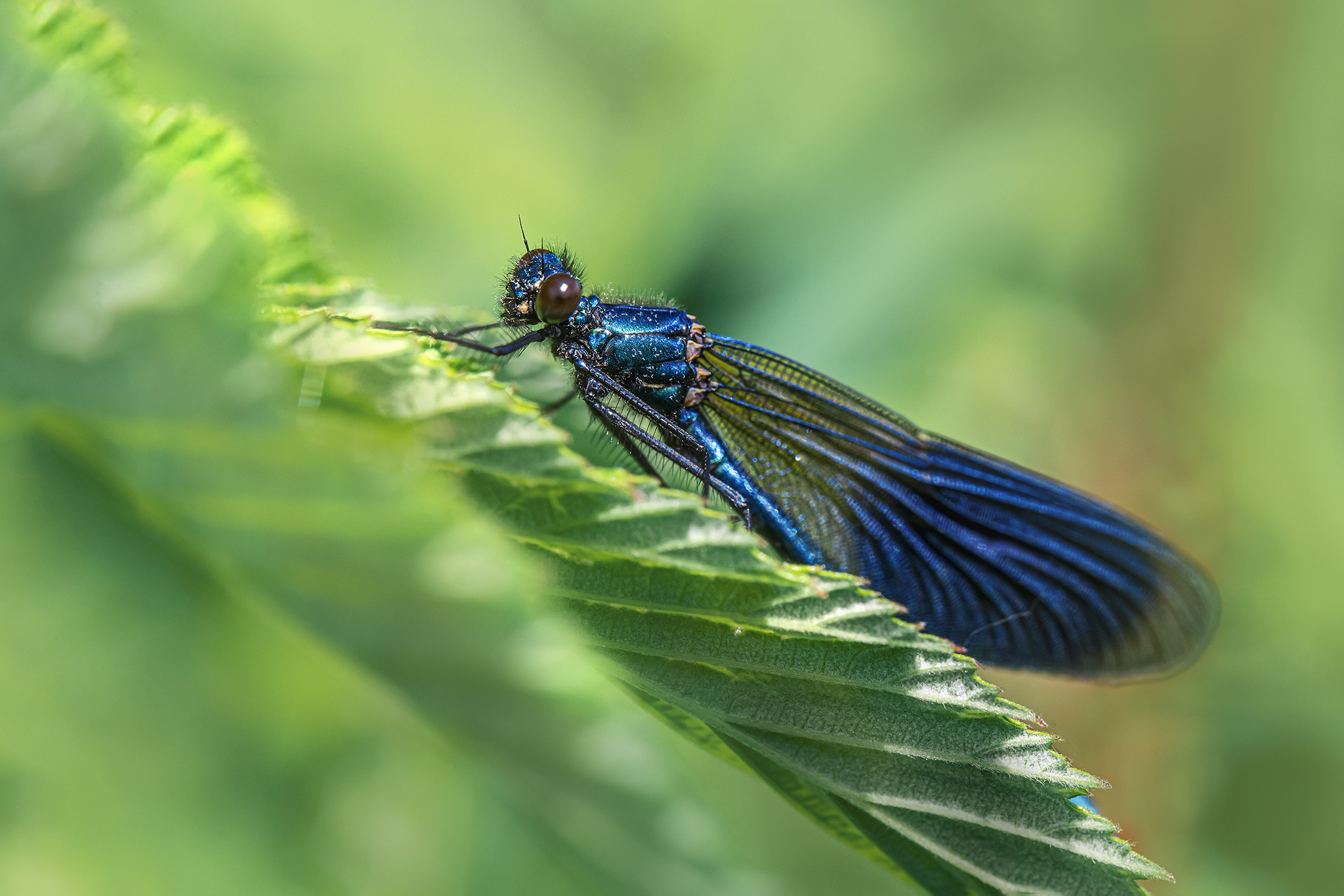Here’s a full and detailed overview of the Beautiful Demoiselle (Calopteryx virgo), one of Europe’s most striking damselflies.
🪰 Beautiful Demoiselle (Calopteryx virgo)
Taxonomy
- Kingdom: Animalia
- Phylum: Arthropoda
- Class: Insecta
- Order: Odonata
- Family: Calopterygidae
- Genus: Calopteryx
- Species: C. virgo
Common name: Beautiful Demoiselle
Scientific name: Calopteryx virgo
Identification
The Beautiful Demoiselle is a large, elegant damselfly recognized for its metallic sheen and graceful flight over streams and rivers. It is one of the most visually stunning insects in Europe.
- Length: 45–49 mm
- Wingspan: 60–70 mm
- Male: Metallic blue-green body with dark blue, opaque wings
- Female: Metallic green-bronze body with smoky greenish-brown translucent wings and a distinctive white pseudopterostigma (false wing spot)
- Eyes: Large and brownish-red
- Legs: Long, black, and spindly
The species can be distinguished from the Banded Demoiselle (Calopteryx splendens), which has a distinct dark band on the male’s wings rather than full coloration.
Distribution and Range
The Beautiful Demoiselle is widespread across:
- Europe – from the British Isles and Scandinavia to the Mediterranean and the Balkans
- Asia Minor – extending east into parts of western Asia
It is absent from much of the Iberian Peninsula and some lowland regions of central Europe.
Habitat
This species prefers:
- Clean, fast-flowing streams and rivers
- Wooded or shaded waterways
- Grassy banks and riparian vegetation
The larvae require well-oxygenated water and are found among submerged roots and leaf litter in running streams.
Behavior
- Flight period: May to September (depending on climate)
- Activity: Flies in sunshine, often perching on vegetation near water
- Territorial males: Defend stretches of stream, performing aerial displays with fluttering wings
- Courtship: Males display to females by fluttering their wings and curving their abdomen in a heart-shaped “dance” over the water
- Resting: Often seen perched on overhanging plants or rocks
Diet
Both adults and larvae are carnivorous:
- Adults: Feed on small flying insects such as midges, mosquitoes, and gnats caught in flight
- Larvae (nymphs): Feed on aquatic invertebrates and small insect larvae
Life Cycle
- Mating: Occurs over water; the male clasps the female by the neck with his abdominal claspers.
- Oviposition: The female lays eggs underwater, inserting them into submerged plants.
- Larval stage: Lasts 1–2 years, depending on temperature and water quality.
- Emergence: Mature larvae crawl out of the water to metamorphose into adults.
Adults live only a few weeks, during which they reproduce.
Lifespan
- Larval stage: 1–2 years
- Adult stage: 2–4 weeks
Conservation Status
- IUCN Red List: Least Concern (LC)
- Population trend: Stable, but locally sensitive to water pollution and habitat degradation
Protection of clean, fast-flowing water systems is essential for this species’ survival.
Ecological Role
- Indicator of clean, oxygen-rich water ecosystems
- Controls populations of small aquatic and flying insects
- Prey for birds, frogs, and dragonflies
Predators and Threats
- Predators: Birds, amphibians, spiders, and larger dragonflies
- Threats:
- Water pollution and sedimentation
- Riverbank modification and vegetation loss
- Climate change affecting stream flow
Key Identification Points
| Feature | Description |
|---|---|
| Scientific name | Calopteryx virgo |
| Common name | Beautiful Demoiselle |
| Family | Calopterygidae |
| Length | 45–49 mm |
| Wingspan | 60–70 mm |
| Male wings | Dark blue and opaque |
| Female wings | Greenish-brown translucent |
| Habitat | Fast, clean rivers and streams |
| Flight period | May–September |
| Conservation status | Least Concern |
Interesting Facts
- The name Calopteryx means “beautiful wing” in Greek.
- Males display a courtship dance by flicking their wings and curving their bodies to attract females.
- They are among the few damselflies that can tolerate shaded woodland streams.
- The coloration is structural, caused by microscopic scales reflecting light, not by pigment.
Summary
The Beautiful Demoiselle (Calopteryx virgo) is a striking damselfly that graces clean, fast-flowing European streams with its metallic blue and green shimmer. Males dazzle with their fully dark wings and courtship displays, while females exhibit subtler bronze hues. As an indicator of unpolluted water, this species plays an important ecological role and remains a symbol of pristine freshwater habitats.
Views: 3067
Subscribe to the newsletter:
